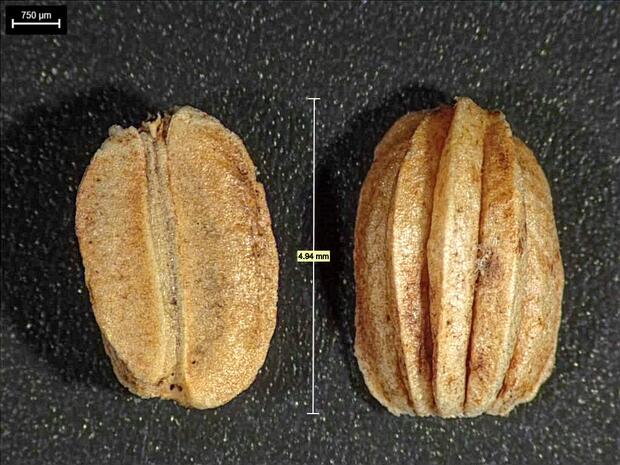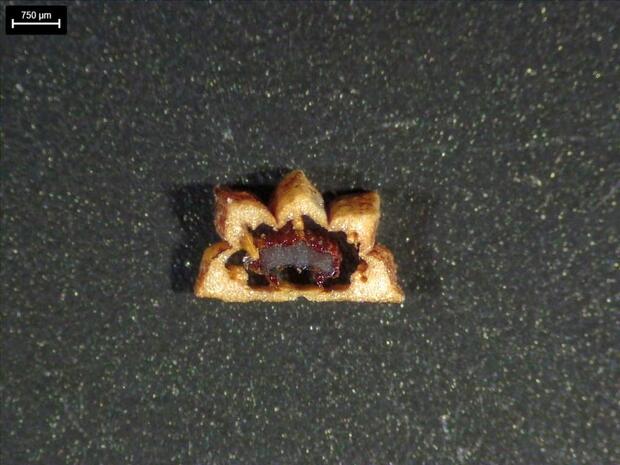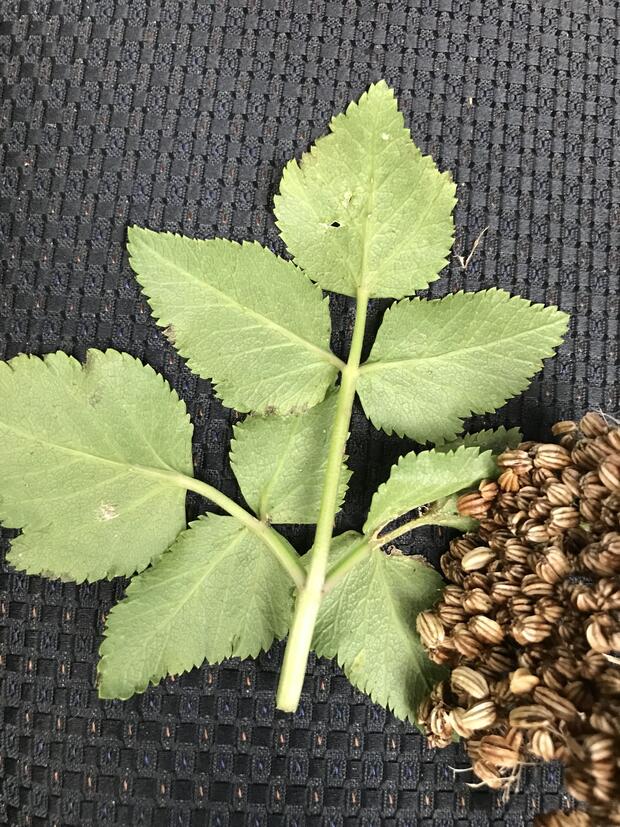- Scientific name: Angelica lucida L.
- Synonyms: Coelopleurum lucidum (L.) Fern.
- Species of Greatest Conservation Need (MA State Wildlife Action Plan)
Description
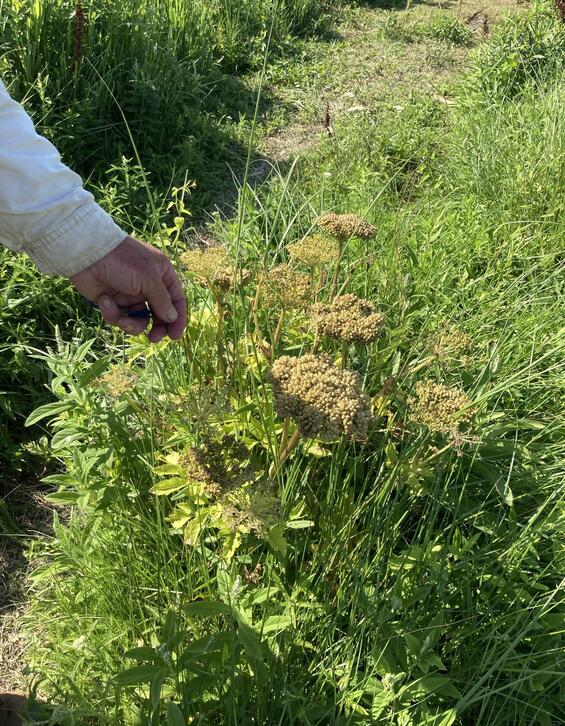
Sea coast angelica. Image credit: Jake McCumber CC BY-SA 4.0
Angelica lucida is a tall herb in the celery or carrot family (Apiaceae) with a thick hollow stem that can often be found the following year. Lower leaves can be abundant and spreading to a circle extending about 46 cm (18 in) from the stem. Flowers are a creamy white color. The seed heads are broad and flat with dozens of seeds about the size of a large grain of rice. Often the plant occurs in a dense clump with multiple fruiting stems. Other species of Angelica are planted in gardens or grow wild in marshes. This species’ distribution hugs the coastline.
Height: up to 1.5 m (50 in)
Leaves: compound, divided into broad leaflets with each egg-shaped leaflet serrated on the margins from base to tip, bright, glossy green and somewhat thickened.
Life cycle and behavior
Angelica lucida is perennial and generally flowers every year.

Angelica lucida flowers can appear throughout the month of June and begin setting fruit in July. Fruit is visible generally all the way through October.
Population status
Angelica lucida has been tracked by state botanists as a watch-list species since 1990 and has ten records that are not considered historic (found within the last 26 years). iNaturalist has 11 research grade locations for this species along the entire coast. Given that this plant is readily observed, it is unlikely that many more populations will be found.
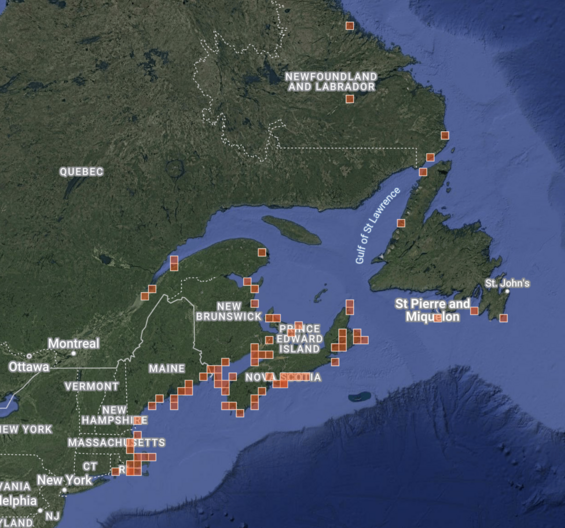
Map of research-grade observations of Angelica lucida in northeastern North America screen-captured from iNaturalist.org on 10 February 2025.
Distribution and abundance
Angelica lucida is a true species of the colder ocean shores in North America and stretches from Rhode Island north to Newfoundland and Labrador. There are also populations on the shores of the Pacific Northwest stretching up to Alaska and west along the entire chain of the Aleutian Islands.
In Massachusetts, the plant is found on many of the islands, Cape Cod, and north to Cape Ann.
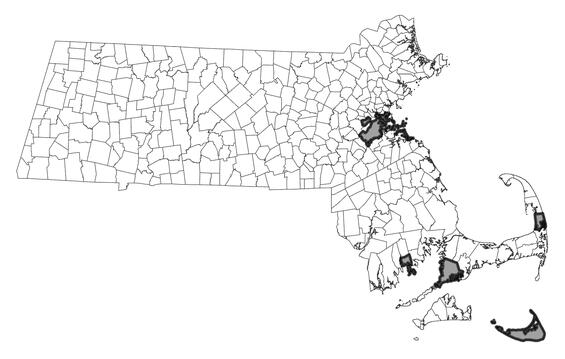
Distribution in Massachusetts
1999-2024
Based on records in the Natural Heritage Database
Habitat
Angelica lucida is generally found on rocky shores within reach of wave splash during storms and usually no further inland, though it could potentially be found on shores of tidally influenced rivers and estuaries.
Healthy habitats are vital for supporting native wildlife and plants. Explore habitats and learn about conservation and restoration in Massachusetts.
Threats
Angelica lucida is particularly threatened by sea-level rise which is expected to continue as the climate warms. Since this species occupies a very restrictive, narrow band between wave splash and solid ground, it is uniquely at very high risk to become extirpated from the state. In the Northeast United States, sea level has risen about 30 cm (1 ft) since the year 1900, faster than the average global rate (Staudinger et al. 2024).
Conservation
Survey and monitoring
Given these are large perennial species and easy to relocate, monitoring could be done on a five-year cycle in the fall with estimates of plant vigor and seed production along with stem counts and whole plant counts.
Management
In general, wave action creates its own habitat management. However, there may be areas where excessive beach erosion may provide the opportunity to rescue individual plants and move them to a nearby location within 100 meters (~300 ft) where the beach is not eroded.
Research needs
Research is needed to determine whether this plant can be grown in a nursery or garden setting for purposes of reintroductions. Questions about seed germination and seed storage over winter will need to be answered. As sea-level rise may create new habitat while at the same time isolating current populations, this strategy for reintroductions could prove useful to long-term conservation of this species.
References
Fernald, M. L. 1950. Gray’s Manual of Botany, Eighth (Centennial) Edition—Illustrated. American Book Company, New York.
Gleason, Henry A., and Arthur Cronquist. Manual of Vascular Plants of Northeastern United States and Adjacent Canada, Second Edition. Bronx, NY: The New York Botanical Garden, 1991.
Haines, Arthur. Flora Novae Angliae. New England Wild Flower Society, Yale University Press, New Haven, CT. 2011.
iNaturalist. Available from https://www.inaturalist.org. Accessed 10 February 2025
POWO (2025). "Plants of the World Online. Facilitated by the Royal Botanic Gardens, Kew. Published on the Internet; https://powo.science.kew.org/ Retrieved 10 February 2025."
Staudinger, M.D., A.V. Karmalkar, K. Terwilliger, K. Burgio, A. Lubeck, H. Higgins, T. Rice, T.L. Morelli, A. D'Amato. 2024. A regional synthesis of climate data to inform the 2025 State Wildlife Action Plans in the Northeast U.S. DOI Northeast Climate Adaptation Science Center Cooperator Report. 406 p. https://doi.org/10.21429/t352-9q86
Contact
| Date published: | March 20, 2025 |
|---|
